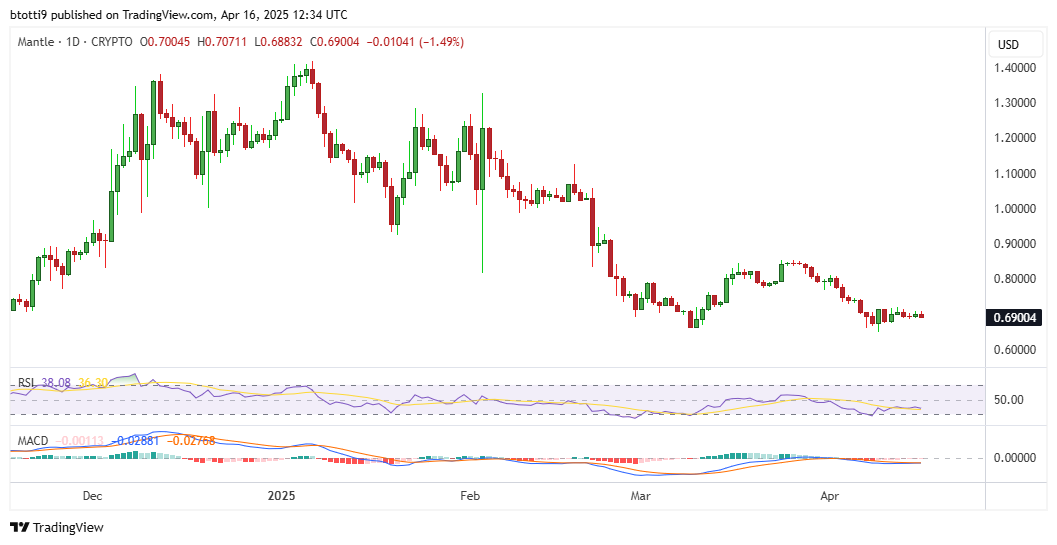- Altcoin market cap falls from $1.6T to $950B in four months.
- Ondo partners with BlackRock, PayPal, Google Cloud.
- Token holds $0.82 but risks drop to $0.70 level.
The cryptocurrency market has entered a pronounced bearish phase, with Coinbase’s April 15 market review confirming a 41% drop in the altcoin market capitalisation.
From a high of $1.6 trillion in December 2024, altcoins now stand at $950 billion, wiping out $650 billion in value.
This downturn has triggered steep declines across the board, particularly for projects that had previously gained institutional traction.
Ondo Finance’s native token, $ONDO, has been one of the hardest hit, falling over 60% from its peak.
The slump comes despite the platform’s expanding real-world asset (RWA) strategy and rising visibility in both corporate and political circles.
While broader macroeconomic pressures and declining risk appetite are weighing heavily on crypto valuations, the case of Ondo highlights the disconnect between market performance and underlying adoption trends.
As institutional partners and high-profile endorsements continue to back the protocol, questions remain about whether this divergence is temporary—or a reflection of deeper liquidity concerns in the tokenised asset space.
Ondo builds RWA network
Ondo Finance, launched in 2021, has become a key player in the RWA sector. The platform aims to bring institutional-grade financial instruments like US Treasuries, bonds, and money market funds to the blockchain.
In February, the project launched its own Layer-1 blockchain focused on RWA tokenisation. It announced collaborations with Google Cloud, BlackRock, PayPal, Franklin Templeton, WisdomTree, and McKinsey.
Despite this momentum, $ONDO is currently trading at $0.8219—down over 60% from its December high. Its broader market structure remains bearish, with price action consistently below the 20, 50, and 200 simple moving averages (SMAs).
Trump-linked backing
Along with corporate partnerships, Ondo has recently attracted political attention. Donald Trump Jr. appeared at the Ondo Finance Summit, and World Liberty Financial—affiliated with the Trump family—invested $460,000 in $ONDO one week before the event.
While this support gained media attention, it hasn’t reversed the market trend.
Ondo also joined Mastercard’s Multi-Token Network (MTN), introducing the Ondo Short-Term US Treasuries Fund (OUSG) as the network’s first tokenised asset.
This move marks a step towards integrating RWAs into mainstream finance, potentially challenging traditional offerings from major asset managers.
$ONDO tests key support
Technically, $ONDO is clinging to support between $0.81 and $0.82, with the 100-period SMA at $0.8161. The token has faced repeated rejections between $0.88 and $0.90—an area of previous institutional interest—pointing to continued resistance at the top.
A breakdown below this support band could send the token toward $0.75–$0.77, or possibly to $0.70, which served as a rebound point in early Q1. These zones remain critical in assessing near-term downside risk.
Nonetheless, the Ondo Global Markets GM platform has helped the protocol cross $1 billion in total value locked (TVL) as of March. Daily trading volume has topped $300 million, with annualised revenue at $6 million, according to DeFiLlama.
Partnerships with high-growth networks like Aptos—which itself has crossed $1 billion in stablecoin TVL—further anchor Ondo within the decentralised finance space.
The short-term picture remains bearish, but with deep integrations across both financial and political sectors, Ondo continues to position itself for long-term relevance in the institutional crypto ecosystem.
The post Ondo Finance price crashes 60% as altcoin market loses $650B appeared first on CoinJournal.

